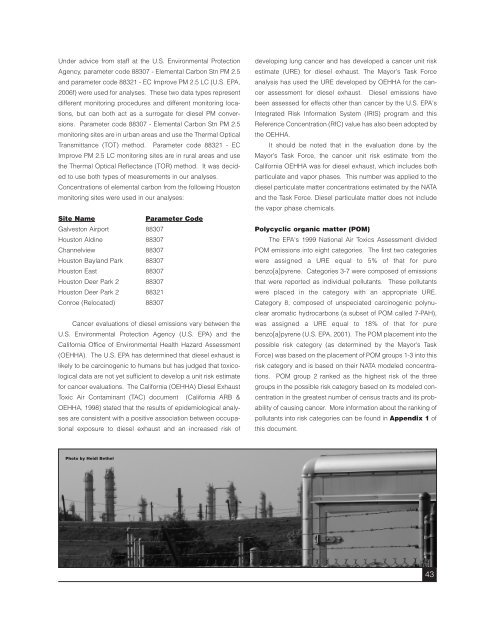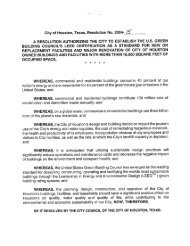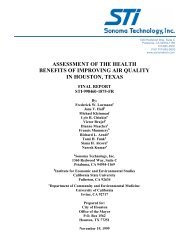A Closer Look at Air Pollution in Houston: - Green Houston
A Closer Look at Air Pollution in Houston: - Green Houston
A Closer Look at Air Pollution in Houston: - Green Houston
Create successful ePaper yourself
Turn your PDF publications into a flip-book with our unique Google optimized e-Paper software.
Under advice from staff <strong>at</strong> the U.S. Environmental ProtectionAgency, parameter code 88307 - Elemental Carbon Stn PM 2.5and parameter code 88321 - EC Improve PM 2.5 LC (U.S. EPA,2006f) were used for analyses. These two d<strong>at</strong>a types representdifferent monitor<strong>in</strong>g procedures and different monitor<strong>in</strong>g loc<strong>at</strong>ions,but can both act as a surrog<strong>at</strong>e for diesel PM conversions.Parameter code 88307 - Elemental Carbon Stn PM 2.5monitor<strong>in</strong>g sites are <strong>in</strong> urban areas and use the Thermal OpticalTransmittance (TOT) method. Parameter code 88321 - ECImprove PM 2.5 LC monitor<strong>in</strong>g sites are <strong>in</strong> rural areas and usethe Thermal Optical Reflectance (TOR) method. It was decidedto use both types of measurements <strong>in</strong> our analyses.Concentr<strong>at</strong>ions of elemental carbon from the follow<strong>in</strong>g <strong>Houston</strong>monitor<strong>in</strong>g sites were used <strong>in</strong> our analyses:Site NameParameter CodeGalveston <strong>Air</strong>port 88307<strong>Houston</strong> Ald<strong>in</strong>e 88307Channelview 88307<strong>Houston</strong> Bayland Park 88307<strong>Houston</strong> East 88307<strong>Houston</strong> Deer Park 2 88307<strong>Houston</strong> Deer Park 2 88321Conroe (Reloc<strong>at</strong>ed) 88307Cancer evalu<strong>at</strong>ions of diesel emissions vary between theU.S. Environmental Protection Agency (U.S. EPA) and theCalifornia Office of Environmental Health Hazard Assessment(OEHHA). The U.S. EPA has determ<strong>in</strong>ed th<strong>at</strong> diesel exhaust islikely to be carc<strong>in</strong>ogenic to humans but has judged th<strong>at</strong> toxicologicald<strong>at</strong>a are not yet sufficient to develop a unit risk estim<strong>at</strong>efor cancer evalu<strong>at</strong>ions. The California (OEHHA) Diesel ExhaustToxic <strong>Air</strong> Contam<strong>in</strong>ant (TAC) document (California ARB &OEHHA, 1998) st<strong>at</strong>ed th<strong>at</strong> the results of epidemiological analysesare consistent with a positive associ<strong>at</strong>ion between occup<strong>at</strong>ionalexposure to diesel exhaust and an <strong>in</strong>creased risk ofdevelop<strong>in</strong>g lung cancer and has developed a cancer unit riskestim<strong>at</strong>e (URE) for diesel exhaust. The Mayor's Task Forceanalysis has used the URE developed by OEHHA for the cancerassessment for diesel exhaust. Diesel emissions havebeen assessed for effects other than cancer by the U.S. EPA'sIntegr<strong>at</strong>ed Risk Inform<strong>at</strong>ion System (IRIS) program and thisReference Concentr<strong>at</strong>ion (RfC) value has also been adopted bythe OEHHA.It should be noted th<strong>at</strong> <strong>in</strong> the evalu<strong>at</strong>ion done by theMayor's Task Force, the cancer unit risk estim<strong>at</strong>e from theCalifornia OEHHA was for diesel exhaust, which <strong>in</strong>cludes bothparticul<strong>at</strong>e and vapor phases. This number was applied to thediesel particul<strong>at</strong>e m<strong>at</strong>ter concentr<strong>at</strong>ions estim<strong>at</strong>ed by the NATAand the Task Force. Diesel particul<strong>at</strong>e m<strong>at</strong>ter does not <strong>in</strong>cludethe vapor phase chemicals.Polycyclic organic m<strong>at</strong>ter (POM)The EPA's 1999 N<strong>at</strong>ional <strong>Air</strong> Toxics Assessment dividedPOM emissions <strong>in</strong>to eight c<strong>at</strong>egories. The first two c<strong>at</strong>egorieswere assigned a URE equal to 5% of th<strong>at</strong> for purebenzo[a]pyrene. C<strong>at</strong>egories 3-7 were composed of emissionsth<strong>at</strong> were reported as <strong>in</strong>dividual pollutants. These pollutantswere placed <strong>in</strong> the c<strong>at</strong>egory with an appropri<strong>at</strong>e URE.C<strong>at</strong>egory 8, composed of unspeci<strong>at</strong>ed carc<strong>in</strong>ogenic polynucleararom<strong>at</strong>ic hydrocarbons (a subset of POM called 7-PAH),was assigned a URE equal to 18% of th<strong>at</strong> for purebenzo[a]pyrene (U.S. EPA, 2001). The POM placement <strong>in</strong>to thepossible risk c<strong>at</strong>egory (as determ<strong>in</strong>ed by the Mayor's TaskForce) was based on the placement of POM groups 1-3 <strong>in</strong>to thisrisk c<strong>at</strong>egory and is based on their NATA modeled concentr<strong>at</strong>ions.POM group 2 ranked as the highest risk of the threegroups <strong>in</strong> the possible risk c<strong>at</strong>egory based on its modeled concentr<strong>at</strong>ion<strong>in</strong> the gre<strong>at</strong>est number of census tracts and its probabilityof caus<strong>in</strong>g cancer. More <strong>in</strong>form<strong>at</strong>ion about the rank<strong>in</strong>g ofpollutants <strong>in</strong>to risk c<strong>at</strong>egories can be found <strong>in</strong> Appendix 1 ofthis document.Photo by Heidi Bethel43







